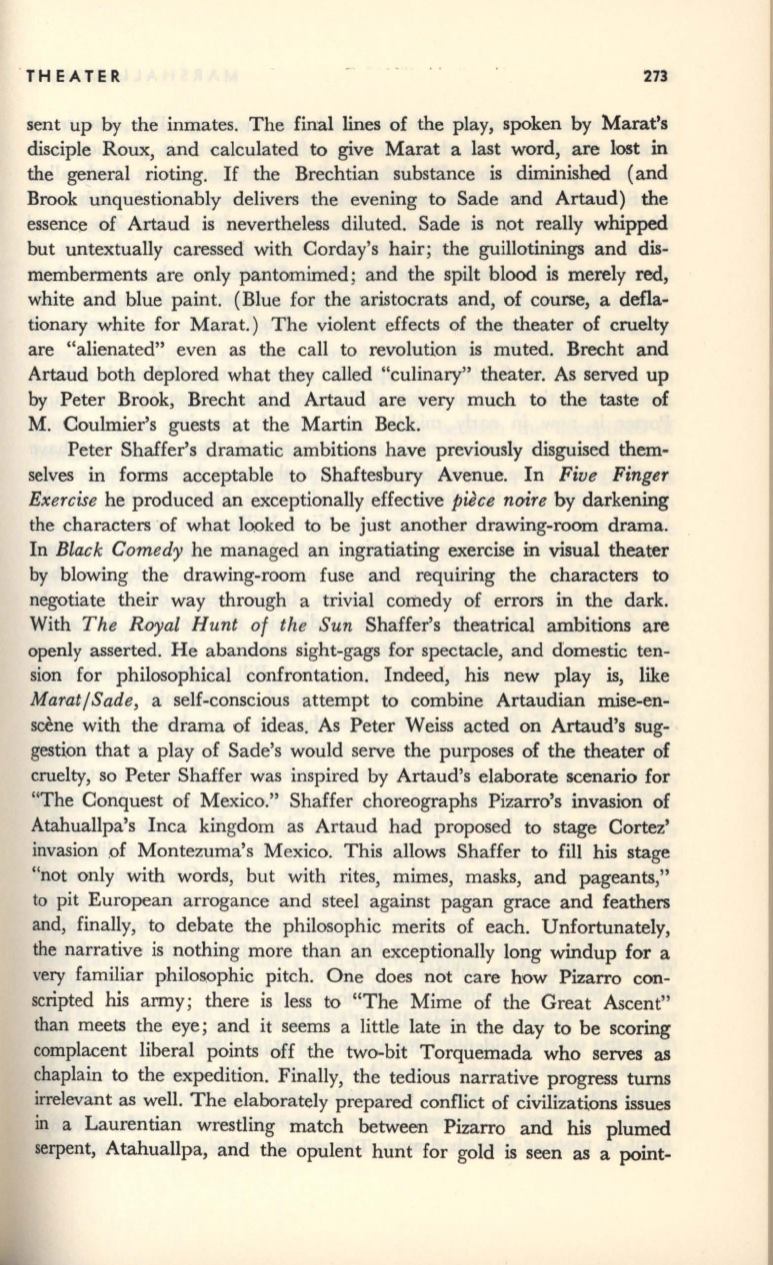
THEATER
273
sent up by the inmates. The final lines of the play, spoken by Marat's
disciple Roux, and calculated to give Marat a last word, are lost in
the general rioting.
If
the Brechtian substance is diminished (and
Brook unquestionably delivers the evening to Sadeand Artaud) the
essence of Artaud is nevertheless diluted. Sade is n.ot really whipped
but untextually caressed with Corday's hair; the guillotinings and dis–
memberments are only pantomimed ; and the spilt blood is merely
red,
white and blue paint. (Blue for the aristocrats and, of course, a defla–
tionary white for Marat.) The violent effects of the theater of cruelty
are "alienated" even as the call to revolution is muted. Brecht and
Artaud both deplored what they called "culinary" theater. As served up
by Peter Brook, Brecht and Artaud are very much to the taste of
M. Coulmier's guests at the Martin Beck.
Peter Shaffer's dramatic ambitions have previously disguised them–
selves in forms acceptable to Shaftesbury Avenue. In
Five Finger
Exercise
he produced an exceptionally effective
piece noire
by darkening
the characters ·of what looked
to
be just another drawing-room drama.
In
Black Comedy
he managed an ingratiating exercise
in
visual theater
by blowing the drawing-room fuse and requiring the characters to
negotiate their way through a trivial comedy of errors in the dark.
With
The Royal Hunt of the Sun
Shaffer's theatrical ambitions are
openly asserted. He abandons sight-gags for spectacle, and domestic ten–
sion for philosophical confrontation. Indeed, his new play is, like
Marat/Sade,
a self-conscious attempt to combine Artaudian mise-en–
scene with the drama of ideas. As Peter Weiss acted on Artaud's sug–
gestion that a play of Sade's would serve the purposes of the theater of
cruelty, so Peter Shaffer was inspired by Artaud's elaborate scenario for
"The Conquest of Mexico." Shaffer choreographs Pizarro's invasion of
Atahuallpa's Inca kingdom as Artaud had proposed to stage Cortez'
invasion of Montezuma's Mexico. This allows Shaffer to fill his stage
"not only with words, but with rites, mimes, masks, and pageants,"
to pit European arrogance and steel against pagan grace and feathers
and, finally, to debate the philosophic merits of each. Unfortunately,
the narrative is nothing more than an exceptionally long windup for a
very familiar philos.ophic pitch. One does not care how Pizarro con–
scripted his army; there
is
less
to
"The Mime of the Great Ascent"
than meets the eye; and it seems a little late in the day to be scoring
complacent liberal points off the two-bit Torquemada who serves as
chaplain to the expedition. Finally, the tedious narrative progress turns
irrelevant as well. The elaborately prepared conflict of civilizations issues
in
a Laurentian wrestling match between Pizarro and his plumed
serpent, Atahuallpa, and the opulent hunt for gold is seen as a point-


